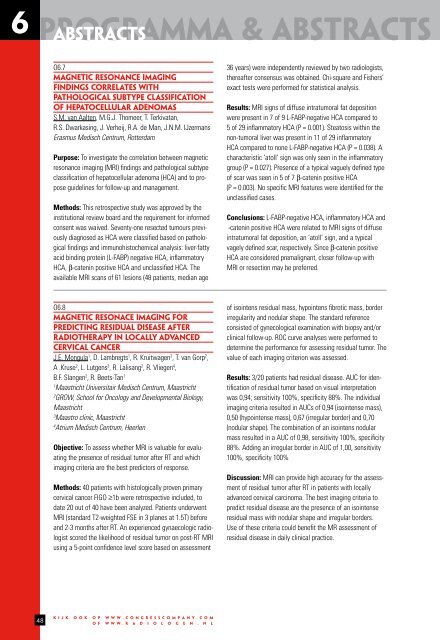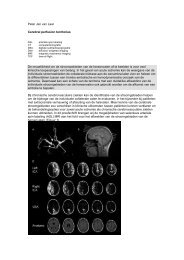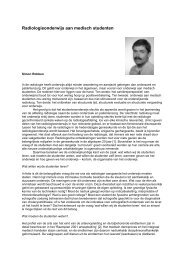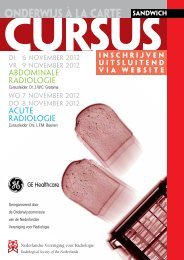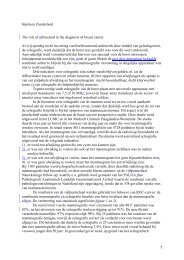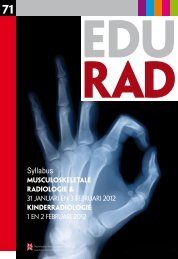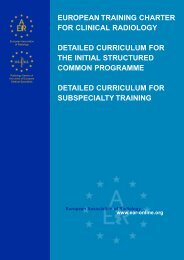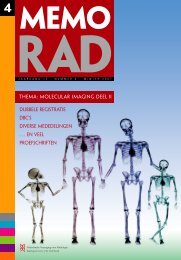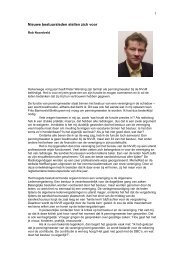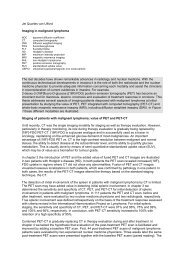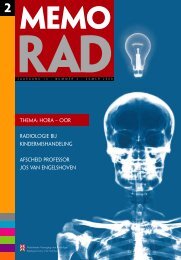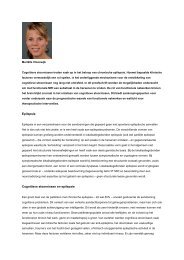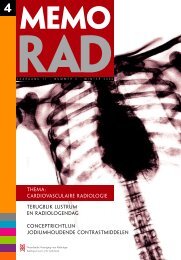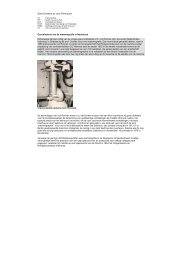programma & abstracts - Nederlandse Vereniging voor Radiologie
programma & abstracts - Nederlandse Vereniging voor Radiologie
programma & abstracts - Nederlandse Vereniging voor Radiologie
You also want an ePaper? Increase the reach of your titles
YUMPU automatically turns print PDFs into web optimized ePapers that Google loves.
6<br />
<strong>programma</strong> <strong>abstracts</strong> & <strong>abstracts</strong><br />
O6.7<br />
MAGNETIC RESONANCE IMAGING<br />
FINDINGS CORRELATES WITH<br />
PATHOLOGICAL SUBTYPE CLASSIFICATION<br />
OF HEPATOCELLULAR ADENOMAS<br />
S.M. van Aalten, M.G.J. Thomeer, T. Terkivatan,<br />
R.S. Dwarkasing, J. Verheij, R.A. de Man, J.N.M. IJzermans<br />
Erasmus Medisch Centrum, Rotterdam<br />
Purpose: To investigate the correlation between magnetic<br />
resonance imaging (MRI) findings and pathological subtype<br />
classification of hepatocellular adenoma (HCA) and to propose<br />
guidelines for follow-up and management.<br />
Methods: This retrospective study was approved by the<br />
institutional review board and the requirement for informed<br />
consent was waived. Seventy-one resected tumours previously<br />
diagnosed as HCA were classified based on pathological<br />
findings and immunohistochemical analysis: liver-fatty<br />
acid binding protein (L-FABP) negative HCA, inflammatory<br />
HCA, β-catenin positive HCA and unclassified HCA. The<br />
available MRI scans of 61 lesions (48 patients, median age<br />
36 years) were independently reviewed by two radiologists,<br />
thereafter consensus was obtained. Chi-square and Fishers’<br />
exact tests were performed for statistical analysis.<br />
Results: MRI signs of diffuse intratumoral fat deposition<br />
were present in 7 of 9 L-FABP-negative HCA compared to<br />
5 of 29 inflammatory HCA (P = 0.001). Steatosis within the<br />
non-tumoral liver was present in 11 of 29 inflammatory<br />
HCA compared to none L-FABP-negative HCA (P = 0.038). A<br />
characteristic ‘atoll’ sign was only seen in the inflammatory<br />
group (P = 0.027). Presence of a typical vaguely defined type<br />
of scar was seen in 5 of 7 β-catenin positive HCA<br />
(P = 0.003). No specific MRI features were identified for the<br />
unclassified cases.<br />
Conclusions: L-FABP-negative HCA, inflammatory HCA and<br />
β-catenin positive HCA were related to MRI signs of diffuse<br />
intratumoral fat deposition, an ‘atoll’ sign, and a typical<br />
vagely defined scar, respectively. Since β-catenin positive<br />
HCA are considered premalignant, closer follow-up with<br />
MRI or resection may be preferred.<br />
O6.8<br />
MAGNETIC RESONACE IMAGING FOR<br />
PREDICTING RESIDUAL DISEASE AFTER<br />
RADIOTHERAPY IN LOCALLY ADVANCED<br />
CERVICAL CANCER<br />
J.E. Mongula 1 , D. Lambregts 1 , R. Kruitwagen 2 , T. van Gorp 2 ,<br />
A .Kruse 2 , L. Lutgens 3 , R. Lalisang 2 , R. Vliegen 4 ,<br />
B.F. Slangen 2 , R. Beets-Tan 1<br />
1<br />
Maastricht Universitair Medisch Centrum, Maastricht<br />
2<br />
GROW, School for Oncology and Developmental Biology,<br />
Maastricht<br />
3<br />
Maastro clinic, Maastricht<br />
4<br />
Atrium Medisch Centrum, Heerlen<br />
Objective: To assess whether MRI is valuable for evaluating<br />
the presence of residual tumor after RT and which<br />
imaging criteria are the best predictors of response.<br />
Methods: 40 patients with histologically proven primary<br />
cervical cancer FIGO ≥1b were retrospective included, to<br />
date 20 out of 40 have been analyzed. Patients underwent<br />
MRI (standard T2-weighted FSE in 3 planes at 1.5T) before<br />
and 2-3 months after RT. An experienced gynaecologic radiologist<br />
scored the likelihood of residual tumor on post-RT MRI<br />
using a 5-point confidence level score based on assessment<br />
of isointens residual mass, hypointens fibrotic mass, border<br />
irregularity and nodular shape. The standard reference<br />
consisted of gynecological examination with biopsy and/or<br />
clinical follow-up. ROC curve analyses were performed to<br />
determine the performance for assessing residual tumor. The<br />
value of each imaging criterion was assessed.<br />
Results: 3/20 patients had residual disease. AUC for identification<br />
of residual tumor based on visual interpretation<br />
was 0,94; sensitivity 100%, specificity 88%. The individual<br />
imaging criteria resulted in AUCs of 0,94 (isointense mass),<br />
0,50 (hypointense mass), 0,67 (irregular border) and 0,70<br />
(nodular shape). The combination of an isointens nodular<br />
mass resulted in a AUC of 0,98, sensitivity 100%, specificity<br />
88%. Adding an irregular border in AUC of 1,00, sensitivity<br />
100%, specificity 100%<br />
Discussion: MRI can provide high accuracy for the assessment<br />
of residual tumor after RT in patients with locally<br />
advanced cervical carcinoma. The best imaging criteria to<br />
predict residual disease are the presence of an isointense<br />
residual mass with nodular shape and irregular borders.<br />
Use of these criteria could benefit the MR assessment of<br />
residual disease in daily clinical practice.<br />
48<br />
k i j k o o k o p w w w . c o n g r e s s c o m p a n y . c o m<br />
o f w w w . r a d i o l o g e n . n l


